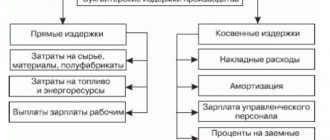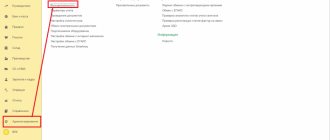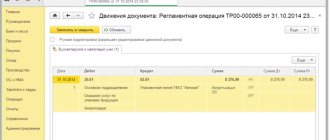Containers are a material asset of an enterprise used for storing, moving and packaging goods. Depending on the purpose and nature of use, containers can be disposable or reusable.
Disposable containers are the packaging we are used to (paper, polyethylene, boxes, bags, etc.). Some categories of goods are placed in it after manufacturing or during the packaging process to preserve their physical and chemical characteristics. In such cases, the packaging remains on the product immediately until it is consumed.
In any trade ]packaging materials[/anchor] are a mandatory expense item, despite the fact that the concept of “packaging” itself is absent in accounting legislation. This is due to the fact that the costs of materials used for packaging are already included in the cost of goods and the buyer does not pay for it separately. Such packaging is positioned in accounting as disposable containers.
As already noted, the costs of preparing goods for sale form their cost (paid by the end consumer). In some cases, reimbursement of costs is borne by the trading organization, and sometimes packaging is not related to trading activities at all.
The packaging process often involves performing a number of complex technological operations using automatic lines, special equipment, materials, etc. In order to simplify tax and accounting, many enterprises consider packaging as an integral element of trade (since when placing a product in consumer packaging, its main characteristics remain the same).
Thus, the purpose of consumer packaging is to ensure the convenience of selling a product to the end consumer. Its price is included in the price of the product.
There are two types of consumer packaging:
- Production - goods are placed in it at a plant, factory, etc. (aerosol cans, cans, tubes, ampoules, etc.);
- Pre-sale, packaging - it is most often used by trading companies selling food products.
How to display packaging costs correctly?
Expenses for disposable packaging can be displayed in accounting in several ways - it all depends on the type of activity of the enterprise.
In production, packaging is part of the material and production assets. To make accounting entries, account 10 “Materials” is used, as well as subaccount 4 “Containers and container materials”.
Subsequent cost accounting is determined by at what stage of production the product is placed in disposable containers:
- Packaging directly during the production process involves writing off expenses for inventories to the debit of account 20 (the amount is included in the cost of goods).
- Packaging of products after production indicates that the amount of costs will be written off to the debit of account 44.
Postings for accounting business expenses
The company collects all business expenses in the debit of account 44.
In accounting records, the company indicates commercial expenses in line 2210 of Form 2. You can see an example of its completion in ConsultantPlus, having received trial access for free.
Let's look at what basic transactions record business expenses in accounting.
| Account by debit | Loan account | Operation description |
| 44 | 02 | Depreciation has been accrued on fixed assets used in trade or for the sale of finished products |
| 44 | 05 | Depreciation has been accrued on intangible assets used in trade or for the sale of finished products |
| 44 | 10 | Costs for the purchase of materials necessary for the sale of goods or products are reflected. |
| 44 | 41 | The cost of goods that the trading company spent for its own needs is included in selling expenses |
| 44 | 43 | The use of finished products for the sale of other items or products is reflected |
| 44 | 60 (76) | Reflects the costs of services of intermediary companies, advertising agencies and other companies that contribute to the growth of sales of goods or products |
| 44 | 70 | Reflects the costs of remunerating sales managers, sellers and other employees associated with the sale of goods or products |
| 44 | 71 | Reflected expenses on advance reports on expenses associated with sales of finished products |
| 44 | 69 for the corresponding subaccount | Insurance premiums have been calculated for the salaries of employees engaged in the sale of goods or products |
| 44 | 94 | Shortages or losses of valuables are included in business expenses |
The accumulated amounts on account 44 are subsequently subject to debiting to account 90. There are 2 ways to do this:
- debiting all amounts accumulated on account 44 in full every month;
- distribution of business expenses for goods sold or products sold.
The chosen method should be indicated in the accounting policy.
If a company completely writes off business expenses on a monthly basis, then an entry should be made in accounting as the debit of account 90 and the credit of account 44. In this case, the final balance of account 44 at the end of the month will be zero.
If the company has chosen the second method of writing off business expenses, then the specific algorithm depends on the type of activity of the enterprise. Trading companies distribute only transportation costs, manufacturing companies - for transportation and packaging. The formula for calculating expenses to be written off is as follows:
KRmes = DTs44 + KRtek – TiURkon
TiURkon = Skon × (TiURtek + DTs44) / (S / Mix + Skon),
Where
KRmes - commercial expenses to be written off for the month;
DTS44 - debit balance of account 44 at the beginning of the month (that is, unwritten off sales expenses for the previous month);
KRTek - business expenses for the reporting month;
TiURkon - transportation costs (and packaging - for manufacturing firms) attributable to the balance of goods at the end of the reporting period;
TiURtek - transportation costs (and packaging - for manufacturing companies) for the current month;
Skon - the cost of goods or products at the end of the month;
C / Mix - the cost of goods or products sold in the current month.
The wiring will be the same:
Dt 90 Kt 44 - commercial expenses are reflected in expenses to be written off for the reporting period.
To understand the difference between the two methods, let's look at an illustrative example.
Important in packaging accounting!
Depending on what accounting policy the enterprise follows, the costs of packaging material are written off: they can be included in full on a monthly basis in the cost of goods, or evenly distributed between warehouse stocks and goods sold.
To account for packaging at retail enterprises, account 41 “Goods” is used, as well as subaccount 3 “Containers under goods and empty”. The packaging costs are written off by posting to the debit of account 44 “Sales expenses”.
In addition, it is allowed to include packaging costs in the cost price. At the same time, the accounting documentation records the posting of the write-off to the debit of account 90, subaccount 90-2 “Cost of sales”. The actual cost of a product is the totality of all costs aimed at improving its consumer characteristics and not related to direct production. This includes work on packaging, sorting, packing, etc.
However, in reality, when taking into account the costs of containers and packaging, a variety of non-standard situations arise. For example, a company purchased goods or sent a batch of manufactured products for storage. In accounting, these transactions are reflected by postings to accounts 41 “Goods” or 43 “Finished Products”. They indicate the initial cost of the inventory, which cannot be changed in the future. How to keep track of packaging costs in this case?
For such situations, accounting provides account 44 “Sales expenses”. However, before the packaging material is turned into packaging, it must be posted to account 10 “Materials”. Documentary evidence of this operation is the M-11 invoice issued in accordance with the established procedure. It is worth noting that account 44 can also be used to show the costs of packaging goods by third parties. The costs for it are written off through the debit of account 90 “Sales”.
Packaging goods: how to account for costs
An integral
part of the expenses of organizations involved in the sale of goods ( products) are the costs of purchasing packaging materials
-
paper, plastic bags twine, tape other things
When packaging is required
Article 481 of the Civil Code of the Russian Federation obliges the seller to transfer the goods to the buyer in containers and (or) packaging, with the exception of goods that, by their nature, do not require packaging and (or) packaging.
For certain types of goods, packaging requirements are established by law. For example, the requirement for the supply of unpackaged food raw materials and food products in packaging materials (paper, bags, etc.) or in clean consumer containers is contained in the Sanitary and Epidemiological
Rules SP 2.3.6.1066-1
approved by the Chief State Sanitary Doctor of the Russian Federation 09/06/2001). Clause 6.1 of these rules establishes that trade organizations must be equipped with packaging materials made from materials permitted by the bodies and institutions of the state sanitary and epidemiological service in the prescribed manner.
In packaged form, without charging an additional fee for packaging, loose food products, as well as fabrics, clothing, fur goods and shoes must be transferred to the buyer (clauses 35 and 45 of the Rules
for the sale of certain types of goods ,
approved by Decree of the Government of the Russian Federation of January 19, 1998 No. 55).
Bread and bakery products sold in small retail outlets must be packaged (clause 9.6 of the Sanitary Rules and clause 37 of the Rules for the sale of certain types of goods).
For your information!
A small retail
trade network is a trade network that carries out retail trade through pavilions , kiosks , tents , as well as mobile means of distribution and distribution trade
-
vending machines auto shops auto shops carts trays baskets and other special devices GOST 51303- 99 "Trade . Terms and definitions" , approved by Resolution the State Standard of Russia dated 08/11/99 242- st .
Accounting
Accounting for packaging costs depends on various factors. For product manufacturers, this is the organization of the packaging process. Packaging of goods can be carried out in a finished goods warehouse or be part of the product manufacturing process and, accordingly, carried out in the main production workshop.
For a trade organization, packaging accounting depends on the procedure for reimbursement of the cost of packaging by the buyer: the cost of packaging may be reimbursed by the buyer as part of the price of the product, in addition to its price, or not reimbursed at all.
Product packaging by the manufacturer
The procedure for accounting for the costs of packaging finished products (single-use containers) is described in Section 3 of the Methodological
Instructions for Accounting Material Inventory Inventories
approved by Order of the Ministry of Finance of Russia dated December 28, 2001 No. 119n; hereinafter referred to as the Methodological Instructions).
Paragraph 162 of this document notes that disposable containers (paper, cardboard, polyethylene, etc.), as well as paper and polymer bags used for packaging products (goods), are usually included in the cost of packaged products and by the buyer are not paid separately.
Manufacturing organizations record purchased packaging materials on the account
10
“Materials” , subaccount 4 “Containers and packaging materials” .
Acceptance of packaging for accounting is reflected by the following entries:
D - t
sch .
10 K-t
sch .
60 - reflects the cost of packaging material indicated in the supplier’s documents
D - t
sch .
19 K-t
sch .
60 – VAT is reflected according to the supplier’s invoice.
After payment for packaging to the supplier, the amount of VAT is subject to deduction:
D - t
sch .
60 Kt .
51 — funds were transferred to the supplier to pay for packaging materials
D - t sch .
68 K - tch .
19 – paid VAT is presented for deduction.
If packaging of products is carried out in the production departments of the organization, the cost of packaging materials is debited from the account
20
“Main production” , vol .
e. included in the production cost of products (clause 172 of the Guidelines):
D - t sch .
20 K - tch .
10. If packaging of products is carried out after the products are delivered to the warehouse, the cost of packaging is included in the cost of sales:
D - t sch .
44 K - tsch .
10. The procedure for writing off packaging costs as part of sales expenses to the cost of products sold ( account
90) is determined by the accounting policy of the organization. Such expenses can be charged to the cost price monthly in full or distributed between sold products and the remaining products in the warehouse.
An organization may not purchase packaging material, but produce it independently. In this case, the costs of its production are first written off from the credit of cost accounts (as a rule, this is account
23 “ Auxiliary production”) to
the debit of account
“ Materials” at
Packaging of goods in trade organizations
Trade organizations to account for the cost of containers of all types (which includes packaging material) use account
41
“Goods”, subaccount 3
“Containers under goods and empty” ( Instructions for using the Chart of Accounts ,
clause 166 of the Methodological Instructions).
Packaging of goods can be carried out by a trade organization directly upon their acquisition or after the goods are received into custody (for example, at the time of sale).
If packaging and packing of goods is carried out upon purchase, the cost of packaging materials is included in the increase in the cost of goods:
D - t
sch . 41 subaccount 1 “Goods in warehouses” K - t account . 41, sub account “ Containers under the goods and empty .
The basis for making such a record is clause 6 of PBU 5/01 “ Accounting
for inventories ” .
According to this paragraph, the actual costs of acquiring inventories include the costs of bringing inventories to a state in which they are suitable for use for the planned purposes, namely the costs of processing, sorting, packaging and improving the technical characteristics of the received inventories, not related to the production of products, performance of work and provision of services.
Example 1
The organization
purchased goods in the amount of 82,600 rubles . ( including VAT - 12,600 rubles ) and packaging material for packaging this product plastic bags in the of 4,720 rubles . ( including VAT - 720 rubles ) . _ The product is packaged and packaged . The goods and packaging have been paid to suppliers .
The following entries will be recorded in the organization's accounting records:
D - t
sch . 41 subaccount 1 “Goods in warehouses” K - t account .
60 - 70,000 rub. — goods received from the supplier
D - t
sch . 19 K - tch . _ 60 - 12,600
rub. — VAT reflected
D - t
sch . 41 subaccount 3 “Containers under goods and empty” K - t account .
60 - 4000 rub. — plastic bags are accepted for accounting
Dt sch . 19
K-t
sch .
60 - 720 rub. — VAT reflected
D - t
sch . 41 subaccount 1 “Goods in warehouses” K - t account . 41 subaccount 3 “Containers under goods and empty”
- 4000 rubles. — the cost of packaging is included in the increase in the cost of the goods
Dt sch . 60
K-t
sch .
51 - 82,600 rub. — the goods have been paid to the supplier
Dt sch . 68
K-t
sch .
19 - 12,600 rub. - submitted for VAT deduction
Dt sch . 60
K-t
sch .
51 - 4720 rub. – packaging cost paid
Dt sch . 68
K-t
sch .
19 - 720 rub. - submitted for VAT deduction.
Accounting for the cost of packaging goods when selling them depends on whether the cost of packaging is reimbursed by the buyer or not.
If the cost of packaging is not reimbursed separately by the buyer, it is included in the distribution costs of the trade organization:
D - t sch .
44 K - tch . _ 41 subaccount 3 “Containers under goods and empty .
Increasing the cost of goods sold by the amount of the cost of packaging in this case is impossible, since in accordance with clause 12 of PBU 5/01, the actual cost of inventories in which they are accepted for accounting is not subject to change (except for cases established by the legislation of the Russian Federation) .
If the packaging material purchased by the organization will be paid in the future by the buyer in excess of the price of the goods (plastic bags, gift boxes), it must be accounted for as an independent product in account
41
subaccount 1
“Goods in warehouses” .
In this case, the transfer of packaging material is reflected in the order of sale.
Example 2
A trading
organization purchased packaging material in the amount of rubles . ( including VAT - 1800 rubles )
. _ organization's accounting
policy provides for the accounting of goods at sales prices . The trade margin on the purchased packaging is 3,540 rubles . The cost of packaging delivered to the sales area is RUB 8,260 . The cost of sold packaging is 5900 rubles .
The purchase and sale of packaging material will be reflected in the following transactions:
D - t
sch . 41 subaccount 1 “Goods in warehouses” K - t account .
60 -
10,000
rub. — the cost of packaging is reflected
Dt sch . 19
K-t
sch .
60 - 1800 rub.
— VAT
D — t
inc . 41 subaccount 1 “Goods in warehouses” K - t account .
42 - 3540 rub. — trade margin reflected
D - t
sch . 41 subaccount 2 “Goods in retail trade” K - t account . 41 subaccount 1 “Goods in warehouses”
- 8260 rubles. — part of the packaging was transferred to the sales area
D - t
sch . 50 K - tch . _ 90 subaccount 1 “Revenue”
- 5900 rubles. — the organization’s cash desk received proceeds from the sale of packaging
D - t
sch . 90 subaccount 3 “VAT” K - t account .
68 - 900 rub.
— VAT
— t
inc . 90 subaccount 2 “Cost of sales” K - t account .
41 - 5900 rub. — the accounting value of sold packaging is written off
D - t
sch . 90 subaccount 2 “Cost of sales” K - t account .
42 - 1542.5 rub. (RUB 5,900 x RUB 3,540: RUB 13,540) — the trade margin related to the packaging sold was reversed
D - t
sch . 90 subaccount 9 “Profit / loss from sales” K - t account .
99 - 642.5 rub. (5900 rubles - 900 rubles - 5900 rubles + 1542.5 rubles) - profit from the sale of packaging is reflected.
Tax accounting
In tax accounting, the taxpayer's expenses for the purchase of materials used for packaging and other preparation of manufactured and (or) sold goods (including pre-sale preparation) are classified as material expenses and are taken into account when determining the tax base for income tax in accordance with subparagraph. 2 p. 1 art. 254 Tax Code of the Russian Federation. As a rule, such expenses are recognized as indirect expenses and are fully attributed to the reduction of the tax base for the income tax of the reporting period (Article 318 of the Tax Code of the Russian Federation).
Based on sub. 2 p. 1 art. 254 of the Tax Code of the Russian Federation, packaging costs are also taken into account when determining the tax base for a single tax by organizations applying a simplified taxation system with the object of taxation “income reduced by the amount of expenses” (Letter of the Ministry of Finance of Russia dated March 14, 2005 No. 03-03-01-04/1 /65). Let us remind you that according to sub. 5 clause 1 and clause 2 art. 346.16 of the Tax Code of the Russian Federation, organizations using the “simplified tax” take into account material expenses in relation to the procedure provided for in Art. 254 Tax Code of the Russian Federation.
Features of accounting for advertising packaging
When packaging goods, an enterprise can put on the packaging any information about the product itself or about the company, print a logo or details, or publish an announcement about upcoming promotions. In all these cases, costs are recorded and accounted for as advertising. And if the cost of a unit of such packaging exceeds 100 rubles, VAT will have to be charged separately on it.
To print advertising on packaging, a retail enterprise needs:
- Provide documentary evidence of the appropriateness of using this packaging;
- The costs of creating/purchasing this packaging will be recognized as indirect, thereby reducing the base income tax rate.
Procedure for maintaining tax accounting of packaging
Income tax
To determine income tax, expenses associated with placing goods in disposable packaging are recorded according to the same principle as in financial statements. Enterprises specializing in the manufacture of products include these costs in the cost of goods or are classified as trading costs. The majority of trading organizations prefer to take them into account in the form of trade costs, while some still reflect these costs in the cost of goods.
As an illustrative example, consider the following situation:
“Our dry cleaning shop purchases special bags made of thick polyethylene from the supplier. We use them to pack clean items when handing them out to clients. The bags protect products from re-contamination and also improve the quality of service - it is convenient for customers to carry bulky items. However, the tax service considered the use of thick bags to be inappropriate. To pack clean items, experts recommended purchasing less expensive materials (paper, thin bags).”
In many manufacturing plants, packaging is an integral part of the product. In such cases, the costs of it (whether purchasing or manufacturing) are considered direct. Everything else is indirect costs of the reporting period, the correct display of which allows you to reduce income tax.
Packaging, as the final production stage (transformation of a product into a commodity), involves the type of expense that is accepted without question by the tax authorities. Everything is very clear here: packaging makes the product suitable for sale. Claims arise if packaging is not necessary in a particular case or if cheaper solutions can be used.
Tax authorities always carefully check the costs of an enterprise, since the amount of income tax depends on this. They pay close attention to expensive packaging: they determine the feasibility and justification of the costs for it, find out whether it is possible to do without it in a particular case. That is why the costs of purchasing packages given to clients free of charge often fall into the “unreasonable” category.
It should be understood that tax authorities do not have the authority to assess costs for their rationality, validity, and feasibility. However, no one wants to have fruitless arguments. It is much more reliable and safer to ask an opinion on this matter directly from a representative of the Russian Ministry of Finance.
“When determining income tax, all expenses that are related to the activities of the enterprise, are economically justified and documented are recognized as appropriate. For example, if a company can prove that additional packaging is necessary to preserve some characteristics of the product, then tax authorities have no right to doubt the advisability of these expenses. Such expenses are quite capable of reducing income taxes. Documentary evidence means: the manager’s order to introduce additional packaging, invoices or sales receipts into the production or sales cycle.”
Value added tax
The company will not have problems deducting VAT from packaging costs if it is a payer of this tax. In this case, the procedure is carried out in the standard manner.
However, many people at this stage have misunderstandings in packaging accounting. For example, packaging costs are included in the cost of production and are not indicated separately in the reporting documentation. The buyer pays only for the product, but at the same time receives both the product itself and the packaging. It turns out that he gets the latter for free. Free transfer of goods is a sale, which means that VAT should also be charged on the cost of packaging. As for the calculation of income tax, it does not take into account the costs of packaging sold free of charge.
This is a fairly common mistake. If the buyer pays for the goods and receives the goods and packaging, then in 100% of cases the costs of purchasing this packaging are already included in the cost of the goods. It does not go to the consumer free of charge; VAT on it is paid along with the general VAT on the product. Thus, no gratuitous sale occurs and no additional tax deductions need to be made.
To obtain an authoritative opinion on this issue, we decided to contact an employee of the Ministry of Finance of the Russian Federation.
“In tax legislation, VAT for a specific enterprise is considered as the total cost of goods sold/transferred to customers at base market prices before taxes are included in them. The contract price of a product may include various company costs (including packaging costs), for which tax is not calculated. Thus, VAT is not charged separately on the cost of packaging.”
Taxation
The procedure for determining and recognizing expenses taken into account in connection with the application of the simplified taxation system (hereinafter referred to as the simplified taxation system) with the object of taxation “income reduced by the amount of expenses” is provided for in Art. 346.16 and 346.17 of the Tax Code of the Russian Federation.
Expenses for paying the cost of goods purchased for further sale are taken into account by the taxpayer applying the simplified tax system as the said goods are sold. Costs directly related to the sale of these goods, including costs of storage, maintenance and transportation, are taken into account as expenses after their actual payment (clause 2, clause 2, article 346.17 of the Tax Code of the Russian Federation).
In accordance with paragraphs. 23 clause 1 art. 346.16 of the Tax Code of the Russian Federation, expenses for payment of the cost of goods purchased for further sale, reduced by the amount of expenses specified in paragraphs. 8 of the same paragraph (for the amount of VAT presented to the organization for VAT on paid goods, works, services), as well as expenses associated with the acquisition and sale of these goods, including expenses for storage, servicing and transportation of goods.
Chapter 26.2 does not contain a closed list of expenses related to the costs associated with the acquisition and sale of goods mentioned in paragraphs. 23 clause 1 art. 346.16 Tax Code of the Russian Federation. In this case, guided by paragraph 1 of Art. 11 of the Tax Code of the Russian Federation, the attribution of costs to these expenses can be made according to the rules established for accounting, i.e. the costs of pre-sale preparation of goods can relate to both the costs associated with the acquisition of goods and the costs of their sale. Consequently, the costs of packaging goods can be included in expenses based on the norm of paragraphs. 23 clause 1 art. 346.16 Tax Code of the Russian Federation.
Let us note that in a similar way, these costs should be taken into account if they are qualified as material expenses (taking into account the taxpayer’s right to independently determine the group to which the costs will be assigned if they can be assigned simultaneously to several groups of expenses with equal grounds ) (clause 4 of article 252, clause 6 of clause 1 of article 254, clause 5 of clause 1 of article 346.16 of the Tax Code of the Russian Federation, see also letter of the Ministry of Finance of Russia dated 09/08/2011 N 03-11-06/2/124 ).
Special procedure for recognizing expenses associated with the acquisition of goods (with the exception of the cost of acquiring the goods themselves), Ch. 26.2 of the Tax Code of the Russian Federation has not been established. In connection with the above, we believe that in the situation under consideration, the taxpayer has the right to take into account the costs of purchasing work (services) for packaging goods in the reporting (tax) period in which he paid for these works (services), regardless of the date of sale of the goods themselves (para. 6 clause 2 clause 2 article 346.17 of the Tax Code of the Russian Federation).
Accordingly, on the same date, the amount of VAT charged to the organization is included in the expenses (clause 8, clause 1, article 346.16, clause 2, article 346.17 of the Tax Code of the Russian Federation).
Please note: the Russian Ministry of Finance expressed the opinion that the costs of bringing goods to a state in which they are suitable for sale are not included in the cost of purchased goods, since this is not provided for in Chapter. 26.2 of the Tax Code of the Russian Federation, and in this regard they cannot be taken into account as part of expenses for the purposes of calculating the single tax (letters of the Ministry of Finance of Russia dated 06/08/2011 N 03-11-06/2/91, dated 02/01/2008 N 03-11-04 /2/25, dated July 11, 2007 N 03-11-05/148).
This opinion does not seem to be indisputable, since, as we indicated above, the costs of bringing goods to a state suitable for sale can be taken into account as expenses when applying the simplified tax system on grounds other than the cost of goods sold itself, in particular, on the basis of paragraphs. 23 clause 1 art. 346.16 of the Tax Code of the Russian Federation as expenses associated with the purchase of goods or their sale.
There are also clarifications from the Russian Ministry of Finance, according to which the costs of paying for work related to the pre-sale preparation of property acquired specifically for resale can be classified as material costs provided for in paragraphs. 6 clause 1 art. 254 of the Tax Code of the Russian Federation, as costs of payment for work (services) of a production nature, performed by third-party organizations (clause 5, clause 1, Article 346.16 of the Tax Code of the Russian Federation, letter of the Ministry of Finance of Russia dated October 24, 2006 N 03-11-04/2/219).
The procedure for filling out the Book of Accounting for Income and Expenses of organizations and individual entrepreneurs using the simplified taxation system (hereinafter referred to as the Procedure) was approved by Order of the Ministry of Finance of Russia dated October 22, 2012 N 135n.
According to clause 1.1 of the Procedure, taxpayers using the simplified tax system keep an Accounting Book of income and expenses of organizations and individual entrepreneurs using the simplified taxation system (hereinafter referred to as the Accounting Book), in which, in chronological order, based on primary documents, they reflect in a positional way all business transactions for the reporting period ( taxable period.
Column 1 of the Accounting Book indicates the serial number of the registered transaction, column 2 - the date and number of the primary document on the basis of which the registered transaction was carried out, and column 3 - the content of the registered transaction. Column 5 reflects the expenses specified in clause 1 of Art. 346.16 of the Tax Code of the Russian Federation (clauses 2.1-2.3, 3.5 of the Procedure).
In the case under consideration, a business transaction that affects the calculation of the tax base for an individual entrepreneur and, in connection with this, is subject to reflection in the Accounting Book, is payment for work (services) for packaging goods. The content of this operation is reflected in column 3 of the Accounting Book, the amount of expenses taken into account when calculating the tax base (the price of the contract for the performance of work (rendering services) for packaging goods) is in column 5 of the same Book. The basis is the corresponding primary document (payment order, receipt for cash receipt order, etc.), the date and number of which are indicated in column 2 of the Accounting Book.





